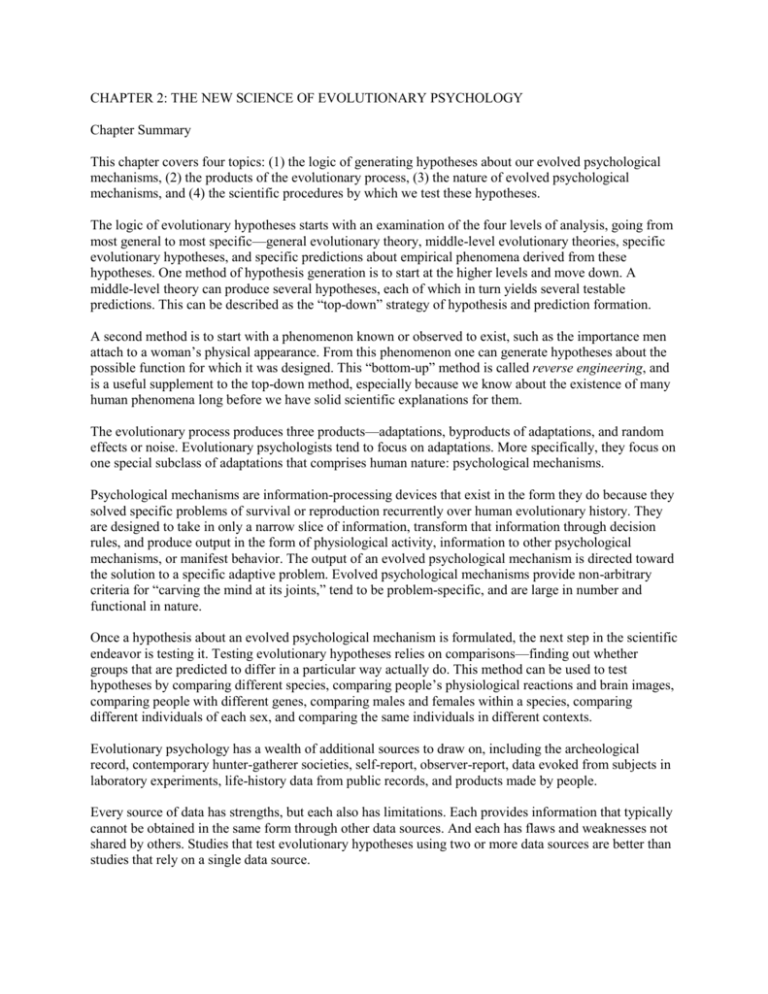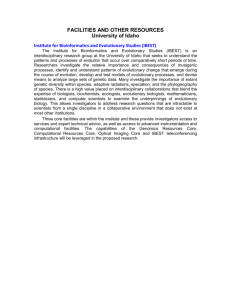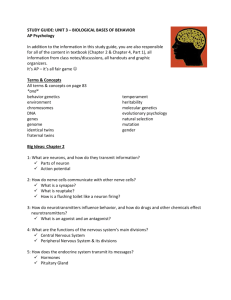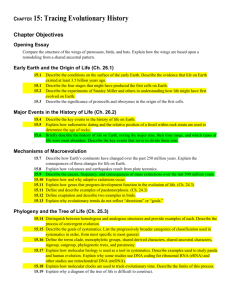CHAPTER 2: THE NEW SCIENCE OF EVOLUTIONARY
advertisement

CHAPTER 2: THE NEW SCIENCE OF EVOLUTIONARY PSYCHOLOGY Chapter Summary This chapter covers four topics: (1) the logic of generating hypotheses about our evolved psychological mechanisms, (2) the products of the evolutionary process, (3) the nature of evolved psychological mechanisms, and (4) the scientific procedures by which we test these hypotheses. The logic of evolutionary hypotheses starts with an examination of the four levels of analysis, going from most general to most specific—general evolutionary theory, middle-level evolutionary theories, specific evolutionary hypotheses, and specific predictions about empirical phenomena derived from these hypotheses. One method of hypothesis generation is to start at the higher levels and move down. A middle-level theory can produce several hypotheses, each of which in turn yields several testable predictions. This can be described as the “top-down” strategy of hypothesis and prediction formation. A second method is to start with a phenomenon known or observed to exist, such as the importance men attach to a woman’s physical appearance. From this phenomenon one can generate hypotheses about the possible function for which it was designed. This “bottom-up” method is called reverse engineering, and is a useful supplement to the top-down method, especially because we know about the existence of many human phenomena long before we have solid scientific explanations for them. The evolutionary process produces three products—adaptations, byproducts of adaptations, and random effects or noise. Evolutionary psychologists tend to focus on adaptations. More specifically, they focus on one special subclass of adaptations that comprises human nature: psychological mechanisms. Psychological mechanisms are information-processing devices that exist in the form they do because they solved specific problems of survival or reproduction recurrently over human evolutionary history. They are designed to take in only a narrow slice of information, transform that information through decision rules, and produce output in the form of physiological activity, information to other psychological mechanisms, or manifest behavior. The output of an evolved psychological mechanism is directed toward the solution to a specific adaptive problem. Evolved psychological mechanisms provide non-arbitrary criteria for “carving the mind at its joints,” tend to be problem-specific, and are large in number and functional in nature. Once a hypothesis about an evolved psychological mechanism is formulated, the next step in the scientific endeavor is testing it. Testing evolutionary hypotheses relies on comparisons—finding out whether groups that are predicted to differ in a particular way actually do. This method can be used to test hypotheses by comparing different species, comparing people’s physiological reactions and brain images, comparing people with different genes, comparing males and females within a species, comparing different individuals of each sex, and comparing the same individuals in different contexts. Evolutionary psychology has a wealth of additional sources to draw on, including the archeological record, contemporary hunter-gatherer societies, self-report, observer-report, data evoked from subjects in laboratory experiments, life-history data from public records, and products made by people. Every source of data has strengths, but each also has limitations. Each provides information that typically cannot be obtained in the same form through other data sources. And each has flaws and weaknesses not shared by others. Studies that test evolutionary hypotheses using two or more data sources are better than studies that rely on a single data source. The final section of this chapter outlines major classes of adaptive problems. Four classes of adaptive problems follow from modern evolutionary theory: problems of survival and growth, problems of mating, problems of parenting, and problems of genetic relatives. Additional insights into identifying adaptive problems come from knowledge of universal human structures, traditional tribal societies, paleoarcheology, task analysis, and current psychological mechanisms. Current mechanisms such as a fear of heights, a taste for fatty foods, and a preference for savanna-like landscapes provide windows for viewing the nature of past adaptive problems. Suggested Readings Barrett, H. C., & Kurzban, R. (2006). Modularity in cognition: Framing the debate. Psychological Review, 113, 628–647. Buss, D. M. (Ed.) (2005). The handbook of evolutionary psychology. New York: Wiley. Crawford, C., & Krebs, D. (Eds.) (2008). Foundations of evolutionary psychology. New York: Erlbaum. Kennair, L. E. O. (2002). Evolutionary psychology: An emerging integrative perspective within the science and practice of psychology. Human Nature Review, 2, 17–61. Pinker, S. (1997). How the mind works. New York: Norton. Tooby, J., & Cosmides, L. (2005). Conceptual foundations of evolutionary psychology. In D. M. Buss (Ed.), The handbook of evolutionary psychology (pp. 5–67). New York: Wiley. Multiple Choice Questions 1. Which of the following theories is the only known scientific theory that can explain adaptations? (b) (a) seeding theory (b) evolution by natural selection (c) inclusive fitness theory (d) creationism 2. Which of the following is not a product of evolution by natural selection? (b) (a) adaptations (b) sexual selection (c) byproducts (d) random effects 3. Adaptations must have which of the following characteristics? (c) (a) must be present at birth (b) must be associated with one particular gene (c) must develop reliably (d) must be easily identifiable 4. Five characteristics of an adaptation include __________. (a) (a) function, efficiency, economy, precision, and reliability (b) mutation, byproducts, economy, genetic drift, and function (c) mutation, efficiency, reliability, function, and economy (d) function, efficiency, economy, inclusive fitness, and optimality 5. The environment of evolutionary adaptedness refers to __________. (c) (a) a time when humans evolved toward a common ancestor with chimpanzees (b) a specific period of human evolution when all adaptations emerged (c) the statistical composite of selection pressures that occurred during an adaptation’s period of evolution responsible for producing the adaptation (d) the environment that is necessary for an adaptation to emerge 6. Adaptations initially start as __________. (b) (a) other adaptations (b) genetic mutations (c) byproducts (d) noise 7. Time periods associated with environments of evolutionary adaptedness are __________. (d) (a) invariable (b) specific to a time and place (c) not unique to each adaptation (d) unique to each adaptation 8. Byproducts __________. (a) (a) do not solve adaptive problems and have no functional design (b) do not solve adaptive problems but do have functional design (c) do solve adaptive problems and have no functional design (d) do solve adaptive problems and do have functional design 9. Which of the following is an example of a byproduct? (c) (a) light produced by a light bulb (b) yawning produced by being tired (c) bellybutton produced by umbilical cord (d) calluses produced by friction 10. What is the first level of analysis in evolutionary psychology and evolutionary biology? (c) (a) theory of parental investment (b) theory of reciprocal altruism (c) inclusive fitness theory (d) theory of parent-offspring conflict 11. General evolutionary theory would be proven false if which of the following facts were uncovered? (b) (a) Men and women do not differ in the affection they report towards their partners. (b) Adaptations emerged in time periods too short for natural selection to have operated. (c) Lamarck’s theory about acquired characteristics was found to be true. (d) Humans had group-level adaptations. 12. Which of the following theories predicts psychological differences between men and women? (c) (a) theory of reciprocal altruism (b) theory of parent-offspring conflict (c) theory of parental investment (d) inclusive fitness theory 13. The __________ an organism invests in parenting, the __________ it has to lose by making a bad mate choice. (a) (a) more; more (b) less; more (c) first time; less (d) more; less 14. In which of following species do males make greater investments in their offspring than females? (d) (a) poison dart frog (b) kangaroo (c) zebra finch (d) pipefish seahorse 15. All of the following hypotheses can be generated based on women’s preference for men with high status except __________. (d) (a) women will value qualities known to be linked with the acquisition of resources (b) women will gaze more at higher-status males (c) women will be interested in sexual intercourse earlier in the relationship when the male is of higher status (d) women will be less likely to divorce husbands who fail to provide resources 16. The first step in the top-down strategy of testing hypotheses is __________. (c) (a) test predictions based on the hypothesis (b) develop a hypothesis about adaptive function based on a known observation (c) derive a hypothesis from existing theory (d) evaluate whether empirical results confirm predictions 17. The first step in the bottom-up strategy of testing hypotheses is __________. (b) (a) test predictions based on the hypothesis (b) develop a hypothesis about adaptive function based on a known observation (c) derive a hypothesis from existing theory (d) evaluate whether empirical results confirm predictions 18. Men prefer a(n) ____________ waist-to-hip ratio than women do. (b) (a) equal (b) smaller (c) larger (d) more masculine 19. An evolved psychological mechanism that led to a successful solution in the evolutionary past ___________ lead to a successful solution now. (c) (a) must (b) will always (c) may or may not (d) cannot 20. Identifying an evolved psychological mechanism requires an identification of its ____________. (a) (a) function (b) physiological characteristics (c) component parts (d) current utility 21. Problem specificity of adaptive mechanisms tends to be favored over generality for the following reasons except __________. (c) (a) general solutions fail to guide the organism to the correct adaptive solutions (b) general solutions lead to too many errors and are costly to the organism (c) general solutions are always anatomically more complex (d) a successful solution differs from problem to problem 22. The __________ mechanisms we have, the ___________ the range of behaviors we can perform. (d) (a) more, smaller (b) fewer, greater (c) fewer, larger (d) more, greater 23. Domain-general mechanisms can be characterized by all of the following statements except __________. (c) (a) they are difficult to identify because there are no domain-general problems (b) the study of domain-generality has not been as fruitful an avenue of scientific pursuit as domainspecificity (c) they do not exist (d) several domain-specific mechanisms working together may appear to be domain-general 24. Are learning and evolved psychological mechanisms mutually exclusive explanations of human behavior, and why or why not? (d) (a) Yes, because evolved psychological mechanisms are reflexes and do not require input from the environment, unlike learning. (b) Yes, because learning overrides our evolved psychological mechanisms. (c) No, because evolved psychological mechanisms are learned during development. (d) No, because learning requires the presence of evolved psychological mechanisms to occur. 25. Which of the following cues was shown to have the most influence on incest avoidance behaviors? (b) (a) degree of genetic relatedness (b) duration of co-residence with a member of the opposite sex during childhood (c) parents passing on knowledge of which individuals are unsuitable for mating (d) amount of time spent playing together during adolescence 26. Psychological mechanisms are theorized to have access only to the information stored within them, and cannot access information contained in other psychological mechanisms except via informationsharing mechanisms. This phenomenon is referred to as __________. (d) (a) compartmentalization (b) repression (c) subconscious (d) encapsulation 27. Male chimpanzees have relatively _________ testes than human males because of the greater selection pressure of female promiscuity in chimpanzees. (a) (a) larger (b) smaller (c) equal (d) fewer 28. Sperm competition is generally present in all of the following species except __________. (a) (a) exclusively monogamous species (b) moderately monogamous species (c) polygamous species (d) promiscuous species 29. Which data source for testing evolutionary hypotheses can be clouded by social desirability motives? (c) (a) human products (b) archeological evidence (c) self-report data (d) public records 30. Which of the following is not a class of adaptive problems? (a) (a) problems of life (b) problems of mating (c) problems of parental investment (d) problems of survival and growth 31. Adaptive problems are challenges that must be overcome for __________. (c) (a) survival of the fittest (b) continuation of the species (c) reproduction or aid in reproduction (d) self-actualization 32. Which of the following is not an adaptive problem caused by an evolutionary history of social hierarchies? (d) (a) protection of one’s resources (b) preventing upstarts from usurping one’s status (c) preventing defection from reciprocally altruistic relationships (d) attracting a mate 33. A task analysis posits which of the following questions: (a) (a) For this structure to occur, what cognitive and behavioral tasks must be solved? (b) What tasks must be present for an adaptation to operate? (c) Why do certain tasks elicit vastly different behaviors? (d) What is the general task that all psychological mechanisms serve? 34. The input to an evolved psychological mechanism __________. (d) (a) can be cues in the external environment or output from other psychological mechanisms (b) is transformed through decision rules (c) is extremely narrow and limited in scope (d) all of the above 35. Which type of cross-cultural study comparison was necessary to distinguish between the social roles hypothesis and the hunting hypothesis explanations of the function of mental rotation skills? (b) (a) comparing cultures that vary in average happiness (b) comparing cultures that vary in gender equality (c) comparing cultures that vary in parasite load (d) comparing cultures that vary in reproductive rate 36. Cross-cultural studies can be used to test evolutionary hypotheses in each of the following ways EXCEPT __________. (a) (a) to determine whether a trait was created by culture or evolution (b) to test whether ecologically dependent adaptations produce predicted differences across cultures (c) to compare the explanatory efficacy of competing evolutionary theories for a given phenomenon (d) to determine whether an adaptation hypothesized to be universal is present in all humans 37. Using physiological measurement techniques, such as hormonal assays, evolutionary psychologists can __________. (b) (a) determine whether a trait or behavior is evolved or not (b) measure proximal influences on an evolved trait or behavior (c) see ultimate causation in action (d) illustrate the phylogeny of a trait under investigation 38. As predicted from an evolutionary perspective, a study by Flinn and colleagues documented that children living with a stepparent have _______ levels of _________ than children living with biological parents. (d) (a) lower; testosterone (b) higher; testosterone (c) lower; cortisol (d) higher; cortisol 39. Which of the following is a limitation of brain imaging techniques for measuring psychological variables? (c) (a) They currently cannot be used to test predictions from an evolutionary perspective. (b) They cannot measure differences within participants, only between groups. (c) Participants must remain immobile when they are exposed to stimuli. (d) all of the above 40. Behavioral genetics methods can test the evolutionary hypothesis that girls growing up without an investing father shift to earlier onset of menarche and sexual behavior. Which of the following behavioral genetics findings would refute this hypothesis? (c) (a) Identical twin sisters raised together enter menarche at the same age, but identical twin sisters raised apart show less similar onset ages for menarche. (b) The environmental component of menarche onset is larger than the genetic component. (c) The genetic component of menarche onset is larger than the environmental component. (d) Age of onset of menarche is not correlated between girls and their biological mothers. 41. Recent studies in molecular genetics have revealed that the 7R allele of the DRD4 gene has been linked to extraversion and novelty-seeking. Evolutionary psychologists hypothesized that such traits would have been adaptive in exploiting novel environments. Which of the following results was documented that supported this prediction? (a) (a) The 7R allele is more common among nomadic populations than sedentary populations. (b) Easterners are more likely to possess the 7R allele than Westerners. (c) Women are more likely to possess the 7R allele than men. (d) The 7R allele is only expressed in childhood but not adulthood. 42. Modern molecular genetics methods have been used to increase our knowledge of recent human evolution in which of the following ways? (d) (a) to show that selection in humans has been accelerating over the past 10,000 years (b) to identify the genes responsible for lactose intolerance (c) to compare competing theories for the timeline of human origins out of Africa (d) all of the above









